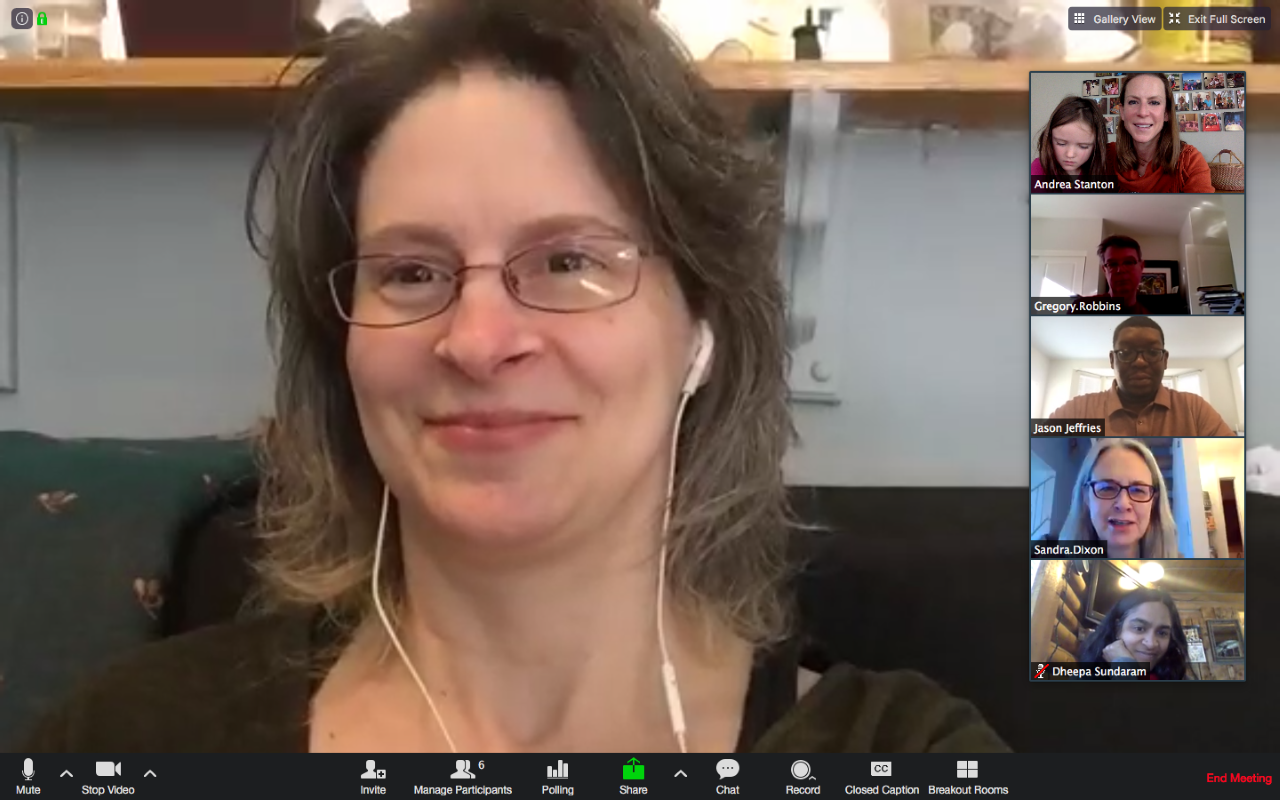Hi all!
My name is Andrea Stanton, and I’m the chair of Religious Studies (CAHSS). We have a BA and MA program and are DU’s anchor department for the DU-Iliff Joint PhD Program in the Study of Religion. Our BA program is pretty small, but nearly 50% of our annual courses count for the undergraduate core curriculum, so we teach a lot of DU undergrads.
My colleagues and I teach online pretty regularly, and we integrate online elements into our on-campus courses all the time. We think that teaching online for Spring Quarter will be an interesting challenge and we are energized by the possibilities. Our conversations have focused on how we can take what we learn from the spring and incorporate it into our department’s overall approach to teaching.
For the past couple of years, we’ve been using Zoom for first-round job interviews, for department meetings when someone is traveling, to connect with colleagues elsewhere, and even for meeting DU colleagues, when the weather is bad and we don’t feel like crossing Evans. (We’ve been doing optional 9am check-ins this week, for example.) In short, we love Zoom, but we don’t think it has to be anyone’s anchor when teaching online.
In this two-part blog series, we’d like to make a pitch for thinking of the Spring Quarter as offering an opportunity to experiment, to be part of a community of learners with your students, and to do so primarily with some easy-to-set up uses of Canvas that support asynchronous learning (students working at their own pace, within a window of time). While these ideas won’t work for everyone, what we want to stress is that they can promote meaningful, effective learning, grounded in solid pedagogical principles – without exhausting you or your students.
Here are some of our thoughts:
Trying to teach your exact same course, with the exact same assignments, readings, and class session structure will likely, as our associate dean Ingrid Tague says of other dead ends, “end in tears”. But feeling that you have to change your entire course seems unnecessary, too.
First, we suggest communicating with your students. Polls of our undergrads suggest that almost none have used Zoom before and that many are nervous about Spring Quarter, not to mention the overall world situation. Email them this week and email them next week. Introduce yourself. We like the word “experiment” and we like the idea of saying that we will all be part of a “community of learners” – that we’re all in it together. These emails don’t need a lot of content – just set the tone.
Then, the course. What tweaks can you make that will support meaningful learning for students and give you and them some enjoyable moments this quarter?
Discussion Posts and Responses
Many of us regularly incorporate discussion posts / responses in our on-campus courses. They are generally a delight to grade and seem to be a delight for students. First, break students into groups of 5-7 students, so they aren’t slogging through 30 or 60 other posts and can form a cohort in their discussion groups. Then, set up the discussions: group discussions, graded, with one for each week.
For example, you might have students post a 300-word discussion post, following a short recorded lecture, on Tuesday by 11pm and respond to two others in the group with 200-250-word responses by Thursday 11pm. You can offer specific prompts or give them free rein to respond to anything in the lecture / reading / outside video. These assignments provide regular opportunities for low-stakes writing, cohort creation, and meaningful learning. In my on-campus undergrad course this winter, posts and responses together count for 30% the final course grade. (As one dismayed student pointed out several years ago: “This means I can’t just take one exam and tune out for the next few weeks.” That’s right: discussion assignments require students to stay engaged.) By the end of the quarter, they will have written 20+ pages, spaced over regular intervals. They will also be thinking about your course at least two days per week, and will gain valuable skills in engaging collegially online with colleagues.
Grading is easy: choose one discussion group and click on “open speed grader” for one student at a time. Offer one substantive comment (Mine usually start with: “Thanks for your thoughtful comments, X” or “You raise an apt point, Y” and add a sentence commenting on the substance of their post) and grade. Keep the discussion so that students are talking to one another and keep it a low-stakes, formative assignment.
Reading Analyses / Reading Response Posts and Responses
This is a variation of the above. When I’m focusing more on teaching critical reading skills, or working with graduate students, I tend to use reading analyses or reading response posts. I tend to use the same prompt over and over, with more structured questions about author, argument, questions they have after reading, etc – its good preparation for writing a scholarly book review. (If you’re looking for inspiration, you might start with https://www.archives.gov/education/lessons/worksheets and modify for different fields and levels).
For undergrads, I like to give them their choice of readings, with one submission due each week. Grad students have to do two. Everyone has to respond to one or two other posts in their group. Honestly, these aren’t as fun to read as the discussion posts and responses, because they tend to be more buttoned-down. But the upside is that it’s a big skills building assignment that helps students become more careful and more critical readers of texts, material culture, films, or anything else you consider “reading”. Again, this assignment offers both meaningful learning and skills building, with limited set-up and grading time.
Next up in Part 2, Quizzes and pulse-takers, Recorded sessions, Live lectures, and Pneumatic tools.



